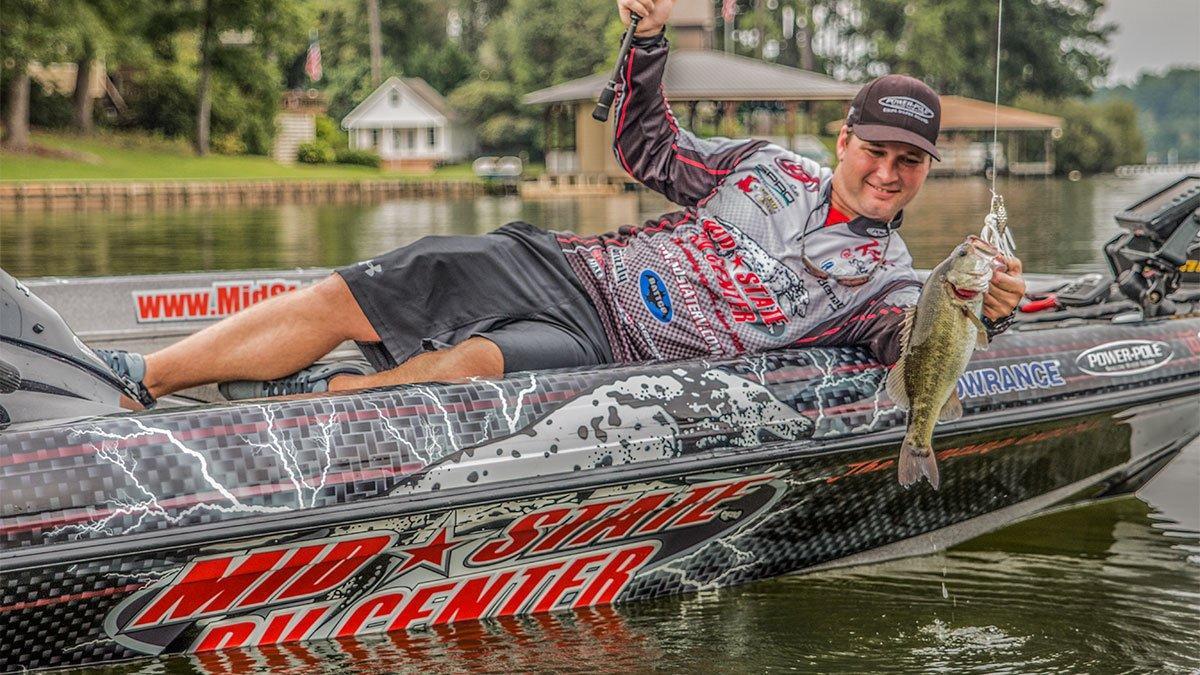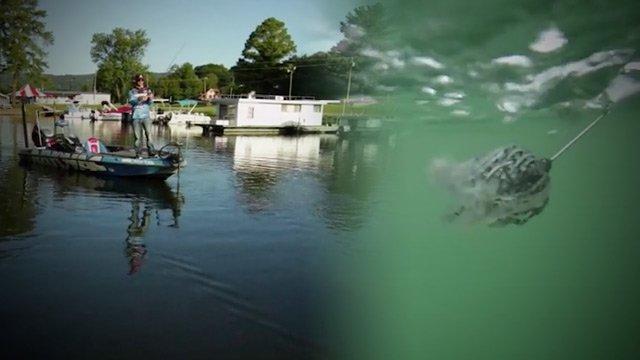In summer and fall, anglers can catch a lot of big smallmouth bass by fishing deep grass on northern lakes. Common spots include veg-covered reefs, weed clumps on flats and sparse grass on points containing baitfish and other smallmouth food. Spinnerbaits, topwaters, flukes, stick baits and hair jigs are great presentations for working the edges of weeds where smallmouth lurk.
If your smallmouth fishing only focuses on rocks and sand, you’re likely bypassing some quality bass relating to grass.
The following 3 factors should be considered for catching smallmouths around the salad:
- Productive areas
- Ingredients of great spots
- Baits for veggie smallies

Top weed areas
Smallmouth bass relate to many types of vegetation and structure combinations on northern lakes. Here are 4 areas to consider when beginning your search.
Isolated weed clumps
Clumps of vegetation, such as cabbage or milfoil, growing in 6 to 16 feet of water appeal to smallmouth on northern lakes. Clumps are smallmouth magnets on barren mud or sand flats. Sunny, cloudy, calm, windy, rainy – there’s rarely a bad time to fish these plants for bronzebacks.
Pockets of dense, or different, vegetation will also concentrate smallmouth on flats covered in grass. The isolated clumps are like solitary trees offering shade and cover in grassy meadows.
Side-imaging will easily locate clumps on flats. Also keep your eyes peeled for plant clusters when fan casting an area. Waypoint clumps with GPS so you can accurately cast the area on return visits.
Rocky points
It’s no secret; smallmouth like points. They use the structure as a highway from deep to shallow water, and back. Patches of grass growing on points often collect smallmouth, like service stations for weary, hungry travelers.
When hit with waves, points change from roadways to feeding stations. Baitfish using grass as cover get disoriented and become more susceptible to prey. Vegetation is also another obstacle for forage being chased by hunting bass.
Greenery on mid-lake structure
Reefs, humps and islands surrounded by deep water are common smallmouth hangouts. Healthy vegetation makes these spots even better.
There doesn’t need to be a lot of plants either. A tuft of grass can create a spot-on-the-spot scenario. This is the case on one massive, mid-lake hump I fish. A 10-foot patch of grass grows in a sand deposit beside a boulder strip. Giant smallmouth cruise between the boulders and the grass in early morning and on hot, calm sunny days in summer and early fall. Accurate casts are key to catching big smallmouth from this specific zone.
When vegetation’s more abundant on mid-lake structure, smallmouth can be more dispersed. Here, the usual fishing methods come into play to work the edges or skim a bait over the weed tops. Windy conditions often stimulate smallmouth activity on large grass covered humps.
Vegetation edges near deep basins
Outside weed edges adjacent to deep water are another area to find smallmouth bass. These zones are framed by shallow water on at least one side, with a deep drop off on the other. They’re common around shorelines, flats and islands.
Smallmouth will chase baitfish against weed walls. They’ll also cruise the vegetation looking for yellow perch, minnows and other snacks.
Outside beds, cups and fingers concentrate smallmouth. These variations are often better than a long, uniform stretch of a weed wall.

5 ingredients of great grass spots
Not every weed clump or grass line holds smallmouth. Instead, specific ingredients will make one pocket of plants better than another to smallmouth. Here are 5 things to look for.
Healthy greens
Lush, vibrant plants are key. This is important in the fall as plants wilt and die back, beginning in the shallows. Find pockets of healthy veg, and you’ll find smallmouth.
Forage supply
Smallmouth are looking for food around weeds. Seeing baitfish or yellow perch cruising around the greenery is a sign of a good area.
Near deeper water
Focus on vegetation near or along a drop-off. Smallmouth like being able to feed, then make a quick getaway to deep water.
Isolated growth
Isolated patches of vegetation can sometimes concentrate smallmouth better than expansive underwater forests. Likewise, a transition from one plant type to another also attracts bass.
Other habitat
Boulders, chunk rock, sand patches and timber boost the appeal of weeds for smallmouth. Same goes for bottom transitions along plant edges.

6 baits for veggie smallies
There are many good baits to catch smallmouth from grassy areas. Here are six reliable picks for northern lakes.
Topwaters
Cigar and popper surface baits call-up smallmouth holding in and around vegetation. For one reason or another, salad smallmouth can’t resist hitting a surface bait splashing and spitting over their heads.
Spinnerbaits
When weed-covered structure’s hit with waves, a fast retrieve with a tandem or double willow spinnerbait between 1/2- to 1-ounce is a smallmouth slayer.
Cast plant edges. Also burn the bait over the crown and weed tops. Active smallmouth will chase baitfish on the top of the structure.
Bucktail jigs
A hair jig is deadly for dissecting outside edges, bends and cuts in vegetation. These jigs are durable, so they withstand being being ripped through weeds. This commotion triggers reaction strikes from smallmouth.
Carry 1/8- to 3/8-ounce jigs. Some days a slow fall’s better. Other times bass are better tempted by a heavy jig crashing into the floor. I do best with black, brown, black-olive and a yellow perch trio of black-olive-orange.
Tubes
A 3- or 4-inch tube is another reliable jig option. Their lazy, spiraling, sinking action’s a sight smallmouth love to eat. Cast a tube beside a weed edge and then drag and pop it along the floor. This is deadly for crayfish-munching smallmouth.
Stickbaits
A wacky rigged 4- or 5-inch stickbait will catch smallmouth relating to vegetation when other baits fail. Cast the bait over the crown and let it sink towards the weed tops. Also make quarter casts from the outside edge and adjacent deep water for suspending smallies.
Using an O-ring reduces the stickbaits lost when one gets hung up in weeds. Rings also help prevent stick baits from being torn off when a smallmouth jumps and head shakes.

Soft jerkbaits
Pearl, ice, smoke and baby bass Flukes between 4- and 5-inches are must-haves. Tex-posed rigging lets the bait sneak through grass without hang-ups.
Cast a fluke onto weeds. Then twitch it beyond the edge and into open water.
While their largemouth cousins have a reputation for liking grass, smallmouth relate to healthy vegetation containing food. Spend time casting isolated weed clumps and the edges of grass near deep water, and you’ll set the hook on plenty of salad-loving smallmouth this fall.
Other Tips
- Many invasive species hitchhike on aquatic plants from one waterbody to another. Always remove plants from your boat and trailer when the day’s done. Then drain and dry your rig before your next outing.
- A marker buoy’s a great tool for identifying weed clumps. Used as a visual reference, it helps with casting accuracy to weed edges and other prime spots.


















